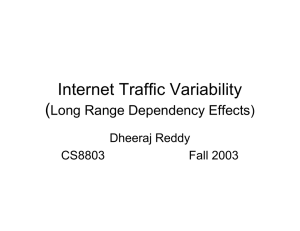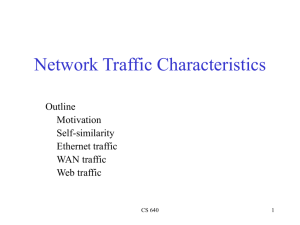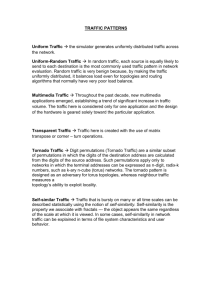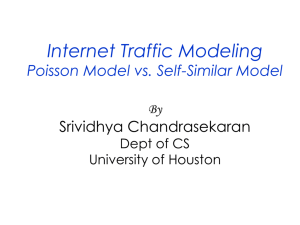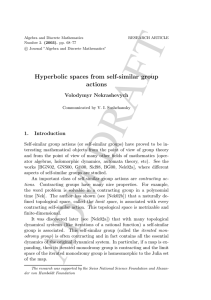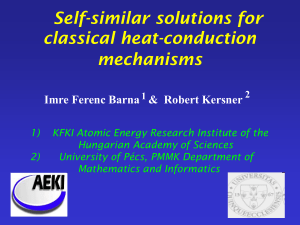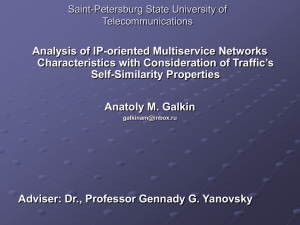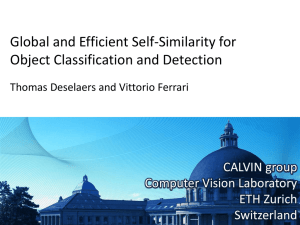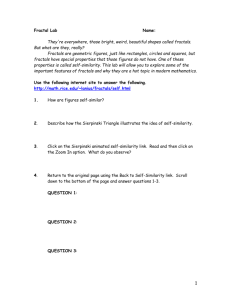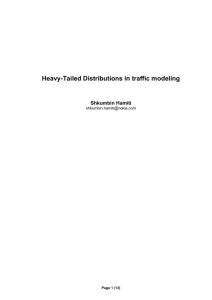Self-Similarity in Network Traffic
advertisement
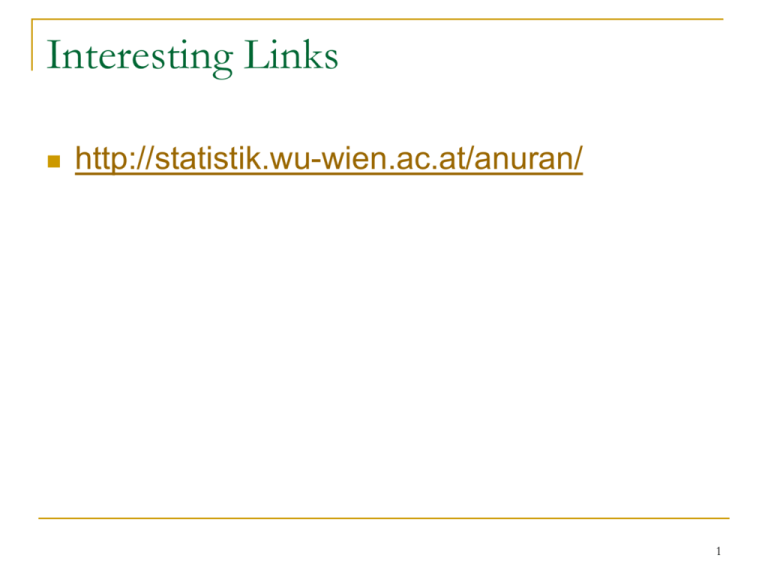
Interesting Links
http://statistik.wu-wien.ac.at/anuran/
1
On the Self-Similar Nature of Ethernet Traffic
Will E. Leland, Walter Willinger and Daniel V. Wilson
Murad S. Taqqu
BELLCORE
BU
Presented by: Ashish Gupta
ashish@cs.northwestern.edu
April 23rd, 2003
Analysis and Prediction of the Dynamic Behavior of Applications, Hosts, and Networks
Prof. Peter Dinda
http://www.cs.northwestern.edu/~pdinda/predclass-s03
Overview
What is Self Similarity?
Ethernet Traffic is Self-Similar
Source of Self Similarity
Implications of Self Similarity
3
Section 1:
What is Self-Similarity ?
Intuition of Self-Similarity
Something “feels the same” regardless of
scale
5
6
7
8
Stochastic Objects
In case of stochastic objects like time-series,
self-similarity is used in the distributional
sense
9
Pictorial View of Self-Similarity
10
Why is Self-Similarity Important?
Recently, network packet traffic has been
identified as being self-similar.
Current network traffic modeling using
Poisson distributing (etc.) does not take into
account the self-similar nature of traffic.
This leads to inaccurate modeling of network
traffic.
11
Problems with Current Models
A Poisson process
When observed on a fine time scale will appear
bursty
When aggregated on a coarse time scale will
flatten (smooth) to white noise
A Self-Similar (fractal) process
When aggregated over wide range of time scales
will maintain its bursty characteristic
12
Pictorial View of Current Modeling
13
Consequences of Self-Similarity
Traffic has similar statistical properties at a
range of timescales: ms, secs, mins, hrs,
days
Merging of traffic (as in a statistical
multiplexer) does not result in smoothing of
traffic
Bursty Data
Streams
Aggregation
Bursty Aggregate
Streams
14
Side-by-side View
15
Section 1.5:
Self-Similarity Definitions
Definitions and Properties
Long-range Dependence
autocorrelation decays slowly
Hurst Parameter
Developed by Harold Hurst (1965)
H is a measure of “burstiness”
also considered a measure of self-similarity
0<H<1
H increases as traffic increases
17
Definitions and Properties Cont.’d
low, medium, and high traffic hours
as traffic increases, the Hurst parameter increases
i.e., traffic becomes more self-similar
18
Properties of Self Similarity
X = (Xt : t = 0, 1, 2, ….) is covariance stationary random
process (i.e. Cov(Xt,Xt+k) does not depend on t for all k)
Let X(m)={Xk(m)} denote the new process obtained by averaging
the original series X in non-overlapping sub-blocks of size m.
E.g. X(1)= 4,12,34,2,-6,18,21,35
Then
X(2)=8,18,6,28
X(4)=13,17
Mean , variance 2
Suppose that Autocorrelation Function r(k) k-β, 0<β<1
20
Auto-correlation Definition
X is exactly second-order self-similar if
The aggregated processes have the same
autocorrelation structure as X. i.e.
r (m) (k) = r(k), k0 for all m =1,2, …
X is [asymptotically] second-order self-similar if
the above holds when [ r (m) (k) r(k), m ]
Most striking feature of self-similarity: Correlation
structures of the aggregated process do not
degenerate as m
21
Traditional Models
This is in contrast to traditional models
Correlation structures of their aggregated
processes degenerate as m
i.e. r (m) (k) 0 as m , for k = 1,2,3,...
Example:
Poisson Distribution
Self-Similar Distribution
22
23
Long Range Dependence
Processes with Long Range Dependence are
characterized by an autocorrelation function
that decays hyperbolically as k increases
r (k )
k
Important Property:
This is also called non-summability of
correlation
24
Intuition
Short-range processes:
Exponential Decay of autocorrelations , i.e.:
r(k) ~ pk , as k , 0 < p < 1
Summation is finite
The intuition behind long-range dependence:
While high-lag correlations are all individually
small, their cumulative affect is important
Gives rise to features drastically different from
conventional short-range dependent processes
25
The Measure of Self-Similarity
Hurst Parameter H , 0.5 < H < 1
Three approaches to estimate H (Based on
properties of self-similar processes)
Variance Analysis of aggregated processes
Analysis of Rescaled Range (R/S) statistic for
different block sizes
A Whittle Estimator
26
Variance Analysis
Variance of aggregated processes decays as:
Var(X(m)) = am-b as m inf,
For short range dependent processes (e.g. Poisson Process),
Var(X(m)) = am-1 as m inf,
Plot Var(X(m)) against m on a log-log plot
Slope > -1 indicative of self-similarity
27
28
The R/S statistic
For a given set of observations,
( X k : k 1,2,....n),
Sample mean X (n), Sample Variance S 2 (n)
Rescaled Adjusted Range or R/S statistic is given by
R ( n)
1
[max( 0, W1 , W2 ,......Wn ) min( 0, W1 , W2 ,......Wn )]
S ( n)
S ( n)
where
Wk ( X 1 X 2 .... X k ) kX (n)
29
Example
Xk = 14,1,3,5,10,3
Mean = 36/6 = 6
W1 =14-(1*6 )=8
W2 =15-(2*6 )=3
W3 =18-(3*6 )=0
W4 =23-(4*6 )=-1
W5 =33-(5*6 )=3
W6 =36-(6*6 )=0
R/S = 1/S*[8-(-1)] = 9/S
30
The Hurst Effect
For self-similar data, rescaled range or R/S
statistic grows according to cnH
For short-range processes ,
H = Hurst Paramater, > 0.5
R/S statistic ~ dn0.5
History: The Nile river
In the 1940-50’s, Harold Edwin Hurst studies the 800-year record of
flooding along the Nile river.
(yearly minimum water level)
Finds long-range dependence.
31
32
Whittle Estimator
Provides a confidence interval
Property: Any long range dependent process
approaches FGN, when aggregated to a
certain level
Test the aggregated observations to ensure
that it has converged to the normal
distribution
33
Recap
Self-similarity manifests itself in several
equivalent fashions:
Non-degenerate autocorrelations
Slowly decaying variance
Long range dependence
Hurst effect
34
Section 2:
Ethernet Traffic is Self-Similar
The Famous Data
Leland and Wilson collected hundreds of
millions of Ethernet packets without loss and
with recorded time-stamps accurate to within
100µs.
Data collected from several Ethernet LAN’s at
the Bellcore Morristown Research and
Engineering Center at different times over the
course of approximately 4 years.
36
37
Plots Showing Self-Similarity (Ⅰ)
H=1
H=0.5
H=0.5
Estimate H 0.8
38
Plots Showing Self-Similarity (Ⅱ)
High Traffic
5.0%-30.7%
Mid Traffic
3.4%-18.4%
Low Traffic
1.3%-10.4%
Higher Traffic, Higher H
39
H : A Function of Network Utilization
Observation shows “contrary to Poisson”
Network Utilization
H
As we shall see shortly, H measures traffic burstiness
As number of Ethernet users increases, the resulting
aggregate traffic becomes burstier instead of smoother
40
Difference in low traffic H values
Pre-1990: host-to-host workgroup traffic
Post-1990: Router-to-router traffic
Low period router-to-router traffic consists
mostly of machine-generated packets
Tend to form a smoother arrival stream, than low
period host-to-host traffic
41
Summary
Ethernet LAN traffic is statistically self-similar
H : the degree of self-similarity
H : a function of utilization
H : a measure of “burstiness”
Models like Poisson are not able to capture
self-similarity
42
Discussions
How to explain self-similarity ?
Heavy tailed file sizes
How this would impact existing performance?
Limited effectiveness of buffering
Effectiveness of FEC
43
Section 3:
Explaining Self - Similarity
Introduction
The superposition of many ON/OFF sources
whose ON-periods and OFF-periods exhibit
the Noah Effect produces aggregate network
traffic that features the Joseph Effect.
Noah Effect:
high variability or
infinite variance
Also known as packet train models
Joseph Effect:
Self-similar or
long-range dependent
traffic
45
The Noah Effect
Noah Effect is the essential point of departure
from traditional to self-similar traffic modeling
Results in highly variable ON-OFF periods :
Train length and inter-train distances can be
very large with non-negligible probabilities
Infinite Variance Syndrome : Many naturally
occurring phenomenon can be well described
with infinite variance distributions
Heavy-tail distributions, parameter
46
Existing Models
Traditional traffic models: finite variance
ON/OFF source models
Superposition of such sources
behaves like white noise, with only short
range correlations
47
Idealized ON/OFF Model
Lengths of ON- and OFF periods are iid positive random
variables, Uk
Suppose that U has a hyperbolic tail distribution,
P(U u) ~ cu
as u , 1 2, (1)
Property (1) is the infinite variance syndrome or the Noah Effect.
2 implies E(U2) =
> 1 ensures that E(U) < , and that S0 is not infinite
48
http://statistik.wu-wien.ac.at/cgi-bin/anuran.pl
49
50
Explaining Self-Similarity
Consider a set of processes which are either
ON or OFF
The distribution of ON and OFF times are heavy
tailed (1, 2)
The aggregation of these processes leads to a
self-similar process
H = (3 - min (1, 2))/2
So, how do we get heavy tailed ON or OFF
times?
51
H : Measuring “Burstiness”
Intuitive explanation using M/G/ Model
As α 1, service time is more variable, easier
to generate burst
Increasing H !
52
Heavy Tailed ON Times and File Sizes
Analysis of client logs showed that ON times were,
in fact, heavy tailed
This lead to the analysis of underlying file sizes
~ 1.2
Over about 3 orders of magnitude
~ 1.1
Over about 4 orders of magnitude
Similar to FTP traffic
Files available from UNIX file systems are typically
heavy tailed
53
Heavy Tailed OFF times
Analysis of OFF times showed that they are
also heavy tailed
~ 1.5
54
Ethernet LAN Traffic Measurements at the Source Level
Location
The first set
Bellcore Morristown Research and Engineering Center
The busy hour of the August 1989 Ethernet LAN
measurements
About 105 sources, 748 active source-destination pairs
95% of the traffic was internal
The second set
9 day-long measurement period in December 1994
About 3,500 sources, 10,000 active pairs
Measurements are made up entirely of remote traffic
55
Textured Plots of Packet Arrival Times
56
Textured Plots of Packet Arrival Times
57
Checking for the Noah Effect
Complementary distribution plots
log( P(U u)) ~ log( c) log( u), as u
Hill’s estimate
Let U1, U2,…, Un denote the observed ON-(or
OFF-)periods and write U(1) U(2) …U(n) for the
corresponding order statistics
1
ˆ n
k
1
(log U ( n1) log U ( nk ) ) , (3)
i 0
i k 1
58
59
60
Important Findings
Most surprising result: Noah Effect is extremely
widespread , regardless of source machine
(fileserver or client machine)
Explanations:
Hyperbolic tail behavior for file sizes residing in file sizes
Pareto-like tail behavior for UNIX processes run time
Human-computer interactions occur over a wide range of
timescales
Although network traffic is intrinsically complex,
parsimonious modeling is still possible.
Estimating a single parameter (intensity of the Noah
Effect) is enough.
61
An example File size Distribution on a Win2000 machine
62
Conclusion
The presence of the Noah Effect in measured
Ethernet LAN traffic is confirmed.
The superposition of many ON/OFF models
with Noah Effect results in aggregate packet
streams that are consistent with measured
network traffic, and exhibits the self-similar or
fractal properties.
Spawned research around the network community
63
Self-similarity and long range dependence in networks
Vern Paxson and Sally Floyd, Wide-Area Traffic: The Failure of Poisson Modeling
Mark E. Crovella and Azer Bestavros, Self-Similarity in World Wide Web Traffic:
Evidence and Possible Causes
It shows that self-similarity in Web traffic can be explained based on the underlying
distribution of transferred document sizes, the effects of caching and user preference in file
transfer, the effect of user ``think time'', and the superimposition of many such transfers in a
local area network.
A. Feldmann, A. C. Gilbert, W. Willinger, and T. G. Kurtz, The Changing Nature of
Network Traffic: Scaling Phenomena ,
Mark Garrett and Walter Willinger, Analysis, Modeling and Generation of SelfSimilar VBR Video Traffic
The paper shows that the marginal bandwidth distribution can be described as being heavytailed and that the video sequence itself is long-range dependent and can be modeled using a
self-similar process
The paper presents a new source model for VBR video traffic and describes how it may be
used to generate VBR traffic synthetically.
64
Heavy tailed distributions in network traffic
Gordon Irlam, Unix File Size Survey,
Will Leland and Teun Ott, Load-balancing Heuristics and Process
Behavior,
Mor Harchol-Balter and Allen Downey, Exploiting Process Lifetime
Distributions for Dynamic Load Balancing
Carlos Cunha, Azer Bestavros, Mark Crovella, Characteristics of WWW
Client-based Traces
This paper presents some of the first Web client measurement ever made. It
characterizes traces taken using an instrumented version of Mosaic from a
university computer lab and shows that a number of Web properties can be
modeled using heavy tailed distributions.
These properties include document size, user requests for a document, and
document popularity.
65
Section 4:
Impact of Self Similarity
Comparison
67
Easy Modeling: Noah Effect
Questions related to self-similarity can be
reduced to practical implications of Noah
Effect
Queuing and Network performance
Protocol Analysis
Network Congestion Controls
68
Queuing Performance
The queue length distribution
Traditional (Markovian) traffic: decreases exponentially fast
Self-similar traffic: decreases much more slowly
Not accounting for Joseph Effect can lead to overly
optimistic performance
Effect of H
(Burstiness)
69
Queuing Performance
Gives rise to infinite mean waiting time: Queue
length distributions themselves exhibit Noah Effect
Buffer requirements can be overwhelming -> Large delays
Traffic Shaping
may be infeasible.
Why ?
70
Protocol design
Protocol design should be expected to take
into account knowledge about network traffic
such as the presence or absence of the Noah
Effect.
71
Thanks !
